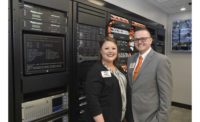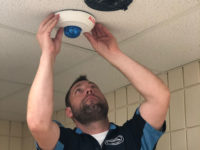False alarms have long troubled video monitoring stations. With stations in Lafayette and Baton Rouge, La. and Chicago, Ill., Acadian Monitoring Services did better than most in the industry, estimating only two of three alarms received were false.
Still, false alarms took a toll on the 70 employees charged with monitoring 10,000 cameras, said Brandon Niles, Acadian’s director of operations.
“Anytime you see false alarms over and over again, you become almost numb and assume the next one will be false, too,” Niles said. “It was hard to keep our operators interested in taking every alarm seriously. If we had only a 1 percent idea an alarm was legitimate, we’d follow our motto, ‘If in doubt, dispatch,’ to be safe.”
Periodically, Acadian lowered the priority of cameras that consistently produced false alarms, a move that didn’t always please customers, which include the center’s sister integration company, Acadian Total Security, and another 500 dealers from all 50 states.
Throughout Niles’ 10 years at Acadian, the company tried anything and everything to find a technology to tame false alarms. Within the last year, Niles found the solution he was looking for from U.K.-based Calipsa.
Calipsa’s cloud-based false alarm filtering platform uses artificial intelligence and deep learning techniques to ignore alarms caused by weather, animals and other non-human activity. Calipsa developed the technology through a lengthy training process that has been conducted over the past four and a half years. Programmers presented millions of human images in various environments to the AI software’s neural networks.
Now, video from customer cameras is routed to the Calipsa cloud, where false alarms are filtered out and genuine alerts are returned to the station, making them easier for operators to identify. Niles said he had concerns about the time required for the process, but ultimately found it was almost instantaneous. Acadian operators still verify all alarms before dispatching security guards or first responders
Niles said the software reduced total false alarms by 99 percent when used by Acadian’s customers. Some of their dealers still use less effective legacy analytic software, but Niles hopes they will see the benefits Calipsa’s software and make the change.
“I’ve looked at about 1,000 software-reviewed events and only one or two weren’t correct,” he said. “This has made a big improvement in my operation and I’m just getting started.”
The platform integrates with a monitoring station’s existing operating software and customers’ cameras. Installation takes minutes without hardware. The software is easily scalable, enabling it to grow with the stations and their customers. Niles said he appreciates the system’s dashboard, which provides performance statistics, and pinpoints idle cameras that may need replacement or a new location at the end user’s site.
Reducing nuisance alarms enabled Acadian’s operators to prioritize events better, respond to genuine alarms quicker and protect sites more efficiently, Niles said. Job satisfaction among station operators has improved, resulting in less turnover. And with fewer false alarms, operators can monitor more cameras during their shifts.
Acadian dealer customers also benefit from the false alarm reduction software. Dealers spend less time at their clients’ sites for false alarm management and there is a lower risk of switching off locations due to high alarm volumes.
But there is no need to worry that the Calipsa software might replace human monitoring station operators, said Brian Baker, vice president, Americas, Calipsa.
“Our software handles the repetitive task of monitoring continuous feeds from thousands of cameras,” Baker said. “We’re able to free operators’ time so they have more time to spend with genuine alarms and other complex tasks.”
With false alarms tamed, Baker predicts the next breakthrough in Calipsa software would be analyzing human behaviors — predicting criminal activity before it occurs.





